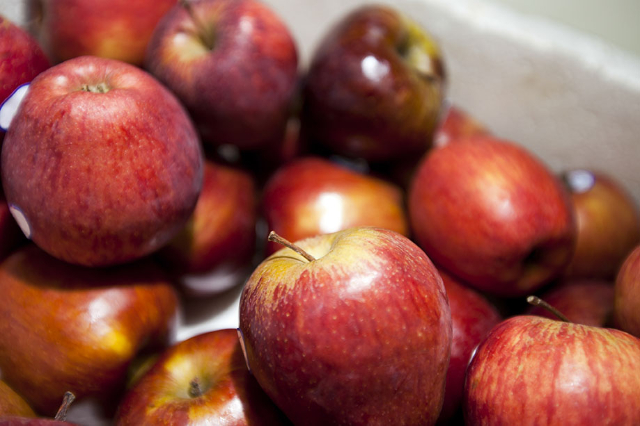9 fruits and veggies to add to your plate this fall
As we say adieu to spring and summer fruit and veggies, let's welcome some delectable fall and winter ones into our kitchens and onto our plates. It may be cool outside, but we can heat up our meals with these flavorful, fun, and healthy fruit and veggies. And by choosing seasonal options, we may not only be able to keep our bank accounts fatter, but our waistlines trim.
Dr. Nina's What You Need to Know About Fall and Winter Fruit and Veggies:
- Apples. It's no wonder they say "an apple a day keeps the doctor away." These tasty fruit are antioxidant powerhouses. In simple terms, antioxidants disarm or neutralize harmful waste products in our body that can cause inflammation, cancer, atherosclerosis and dementia. Apples are also jam-packed with fiber. As a result, they can decrease our bad cholesterol levels and fill us up faster (less calories consumed). And a little known fact is that they can help regulate blood sugars. Compounds in apples can slow down carbohydrate breakdown into simple sugars as well as decrease sugar absorption. The result is decreased blood sugar levels.
- Brussels sprouts. These miniature veggies are in the same family as cauliflower and are making a comeback. They are good sources of protein, iron and potassium. They also contain a healthy amount of Vitamin C which is essential for our immune system, skin, teeth, and gums, and serves as an antioxidant. Consider steaming until soft and then sprinkling olive oil and broiling them on high in the oven for 10 minutes or until crispy. Season with sea salt, parmesan cheese and/or truffle oil.
- Pears. Homer called pears the "gift of the gods" in the Odyssey, and he was right. They are filled with nutrients, fiber and antioxidants. I read that pears have more nutrients per calorie, than calorie per nutrient. Talk about a good return on investment! Additionally, it is considered a "hypoallergenic fruit" because it has a very low likelihood of producing an allergic response. As a result, it is a fruit of choice when introducing pureed foods to infants. Not to mention, the fiber helps decrease bad cholesterol and can help protect our heart as well as be a sweet and sensible snack for diabetics. The reason being, fiber decreases absorption of the pear's carbs and prevents a spike in blood sugar levels.
- Pumpkin. This orange fruit (yes, it is a fruit because it contains seeds) has a number of health benefits. Its radiant color results because it is rich in beta-carotene, an essential nutrient for eye health. Additionally, it contains plenty of fiber, vitamin K, and even some protein while being low in calories and scarce in fat. And let's not forget the seeds. Studies have shown that these yummy seeds can help decrease prostate gland enlargement as well as the risk for kidney stones and depression. After removing those seeds, wipe them off with a paper towel, place a single layer on a cookie sheet, add some seasoning, and roast at 160 degrees for 15-20 minutes to maintain their healthy oils.
- Sweet potatoes. There's a saying: "the best of both worlds." And I think they invented this with sweet potatoes in mind. They are fun like potatoes, sweet in its own right, while being filled with nutrients. Sweet potatoes are rich in Vitamin B6 which helps lower our risk for heart attacks; Vitamin C which can help our immune system fight off icky germs (especially during this time of the year); Vitamin D which can elevate our energy, mood, and bone health; and iron that helps with blood cell production.
- Citrus. Oranges, tangerines, lemons, limes, grapefruit.....scrum-didi-licious. And also filled with Vitamin C and flavonoids. Citrus fruits have been shown to decrease our risk for Alzheimer's dementia, diabetes, cancer, and cataracts. Talk about a win-win-win situation.
- Butternut squash. Another fun, flavorful, fall fruit that many think is a veggie (has seeds). It is rich in nutrients, antioxidants, and fiber while staying low in calories. It is also at the head of its class when it comes to Vitamin A; just 100 grams of butternut squash contains 354% of the recommended daily allowance!
- Kale. Over the last few years this ugly duckling has made a comeback as a beautiful swan. Some have even called it a superfood because it contains such high amounts of Vitamins A, C, and K as well as calcium. Move over spinach! This green leafy veggie has more vitamin C than spinach and its iron is more absorbable by our digestive systems.
- Cabbage. Although possibly best known for Cabbage Patch Kids, this veggie has a number of benefits: weight loss, brain food, healthy skin, cancer protection, blood sugar regulation, and hangover helper.
As we embrace the fall and get ready for the winter months, let's take a trip to the pumpkin patch, an apple farm, explore new recipes, and incorporate these tasty and fun fruit and veggies into our plate.
This article is for general information only and should not be used for the diagnosis or treatment of medical conditions and cannot substitute for the advice from your medical professional. Dr. Nina has used all reasonable care in compiling the current information but it may not apply to you and your symptoms. Always consult your doctor or other health care professional for diagnosis and treatment of medical conditions or questions.




























